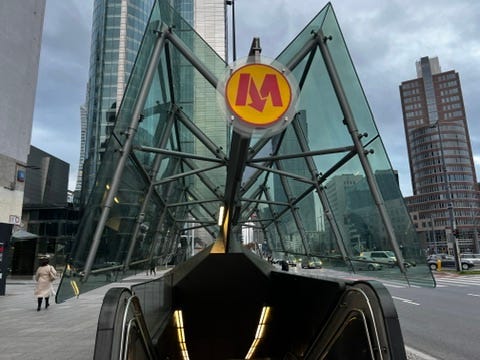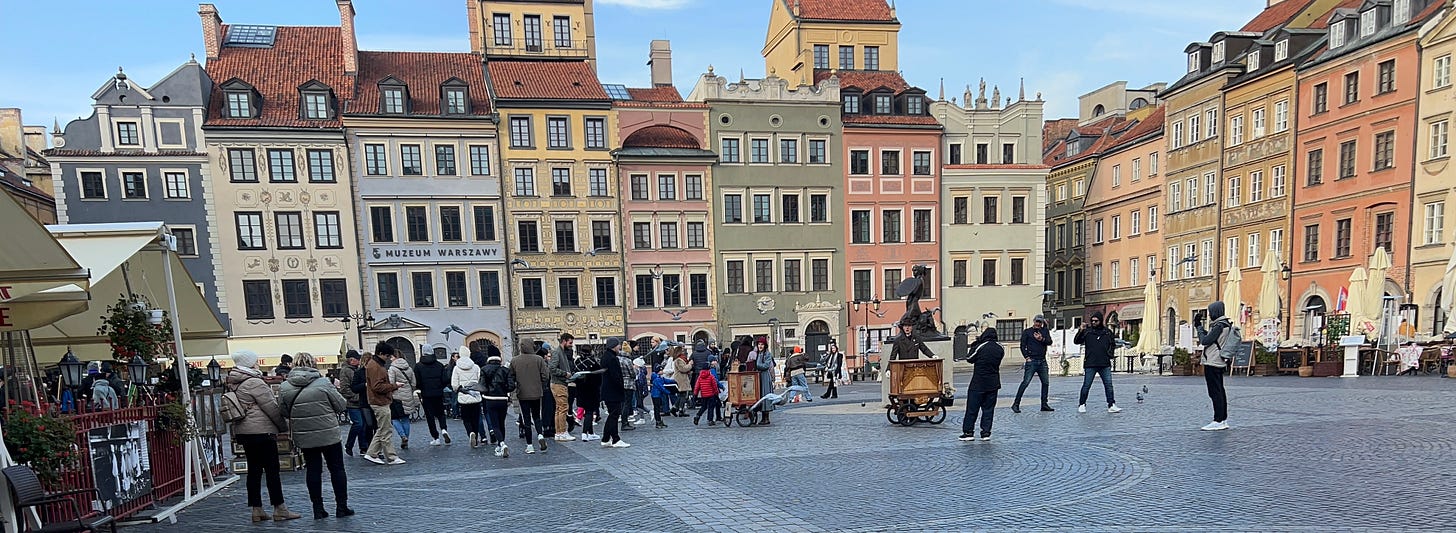On Warsaw
I spent just over a week in Warsaw, having productive meetings with colleagues at the Polish Academy of Sciences, but also exploring the city. It is my first trip to Poland, the land at least a quarter of my ancestors fled 120 years ago. (Though at the time, it was part of the Russian Empire, as the Poles are keen to remind you.)
The city was levelled in World War II (1944) after the Nazis were angered that the Poles had the audacity to rise up and not accept their circumstances. Judging from the photos, it was levelled as much as Nagasaki or Hiroshima (without the radiation), and more than Dresden. The population was reduced from over a million to the tens of thousands. So everything in Warsaw that you see is post-war, even if it looks old.
The architects and planners after the War made a conscious decision to rebuild much of Warsaw (The Old City and the Royal Mile, but notably NOT the Jewish Sector) as it looked in its prime, while rebuilding the rest of the city with a very wide street grid to accomodate trams and cars and pedestrians and bikes (and now scooters). The blocks tend to be long on the major roads, probably due to trams (don’t want pesky cars or pedestrians crossing in front trams needlessly). (This does add distance to access and egress though). The city is generally walkable parallel to the road, if a bit harder to cross orthogonally.
The Old City is lovely, how urbanists, or at least new urbanists, imagine cities should look. It was itself designed originally by Italian architects, so has that kind of feel. The parks are well-maintained and extensive. The modern CBD is humming, doing better than any US CBD for a similarly sized city (3.5M). Many of the new suburbs are midrise apartments around metro stations, though of course single family houses and townhouses distant from any viable transit service are also being built.
There are memorials everywhere of the Jewish Ghetto walls and the Warsaw uprising. The Uprising Museum is quite good, though there is the feeling of “we won this battle, then we won this battle, and then we won this battle, but somehow we lost” which is understandable, obviously the lost battles were not as well documented by the non-survivors. The Polin museum of the History of Polish Jews is also good.
The crows are gray and black (Hooded crows)
I managed to see Polish Independence Day here (November 11, what the rest of us call Veteran’s or Armistice Day). Lots of parading, red and white flags abound. A significant share of the armed forces were marching, though I suspect plenty were still at the border to discourage an invasion from the East. The Nationalists, who just lost the election (gaining a plurality of the votes, but not enough against the coalition of other parties, so they claim they won though they didn’t) were out. The general feeling is pro-NATO, but mixed EU, with many people skeptical of its pro-German orientation (and general distrust of Germany remaining).
The commerce is mostly electronic. The merchants hate making change. A hundred Zloty is rare (still it’s what ATM gave). Transit fares require tickets, or a Warsaw pass (for residents), there is no smart card here, and no credit card payment mechanism for some reason. The ticket machines do accept electronic payment, and are located at Metro stations and key Tram stations, but not every Tram station and not at bust stops. This is annoying for the non-resident.
In the hotel room, one seeks out TV for company. Only news and auto-tuned music videos are in English, but one recognises episodes of many other TV shows. They are hard to watch, though, because the imported TV shows are neither dubbed nor subtitled, instead they have voiceover narrator. This is a strange decision, where the male narrator is speaking over the female actress.
Convenience stores are in every building, most often it seems Zabka (little frog), but also noticeably smaller versions of hypermarket Carrefour, Lewiatan, and Biedronka. They provide what you would expect from a 7-11, though the prices are cheaper (everything is less expensive in Poland) and the bread is fresher (not fresh-fresh, but better than an American would expect from a convenience store). The shopping malls are thriving. They tend to be train-station adjacent.
The Metro is very efficient for where it goes, with high frequency, as are the trams. Some of the stations are somewhat integrated between train and tram (running down the protected median), so under-street connectors will take you to the tram without having to cross the street. Apparently at-grade pedestrian crossings have been restored where previously there were only tunnels. So there is some work on reining in the car.








